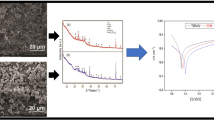Abstract
To compare the surface properties of calcium-ion (Ca2+)-implanted titanium with those of titanium and to investigate the mechanism of bone conductivity of Ca2+-implanted titanium, amounts of hydroxyl radical of Ca2+-implanted titanium and titanium were estimated. Also, the point of zero charge (p.z.c.) of oxide constituting surface oxides of Ca2+-implanted titanium and titanium was determined. Results showed that the amount of active hydroxyl radical on Ca2+-implanted titanium was found to be significantly larger than that on titanium, indicating that the number of electric-charging sites of Ca2+-implanted titanium in electrolyte is more than that of titanium. The p.z.c. values of rutile (TiO2), anatase (TiO2), and perovskite (CaTiO3), were estimated to be 4.6, 5.9, and 8.1, respectively. Thus, Ca2+-implanted titanium surface is charged more positively in bioliquid than titanium, accelerating the adsorption of phosphate ions. © 1998 Chapman & Hall
Similar content being viewed by others
References
T. Hanawa, K. Murakami and S. Kihara, In “Characterization and performance of calcium phosphate coatings for implants, ASTM STP 1196”, edited by E. Horowitz and J. E. Parr (American Society for Testing and Materials, Philadelphia, 1994) p. 170.
T. Hanawa, Y. Nodasaka, H. Ukai, K. Murakami and K. Asaoka, J. Jpn. Soc. Biomater. 12 (1994) 209.
T. Hanawa, Y. Kamiura, S. Yamamoto, T. Kohgo, A. Amemiya, H. Ukai, K. Murakami and K. Asaoka, J. Biomed. Mater. Res. (in press).
T. Hanawa, H. Ukai, K. Murakami and K. Asaoka, Mater. Trans. JIM 36 (1995) 438.
T. Hanawa, H. Ukai and K. Murakami, J. Electron Spectrosc. 63 (1993) 347.
T. Hanawa, K. Asami and K. Asaoka, Corros. Sci. 38 (1996) 1579.
Idem., ibid. 38 (1996) 2061.
A. Kozawa, J. Electrochem. Soc. 106 (1959) 552.
M. Imai and M. Nishio, Sumitomo-Keikinnzoku-Giho 30 (1980) 72.
T. Wakamatsu and S. Mukai, Amer. Inst. Chem. Eng. Ser. 71 (1975) 81.
H. P. Boehm, Disc. Farad. Soc. 52 (1971) 264.
T. Morimoto and H. Naono, Bull. Chem. Soc. Jpn 46 (1973) 2000.
J. Westall and H. Hohl, Adv. Colloid. Interface Sci. 12 (1980) 265.
G. D. Parfitt, Prog. Surf. Membrane. Sci. 11 (1976) 181.
E. J. Kelly, Mod. Aspect. Electrochem. 14 (1982) 319.
T. Hanawa and M. Ota, Biomaterials 12 (1991) 767.
Idem., Appl. Surf. Sci. 55 (1992) 269.
L. L. Hench and E. G. Ethridge, Adv. Biomed. Eng. 5 (1975) 35.
Author information
Authors and Affiliations
Rights and permissions
About this article
Cite this article
HANAWA, T., KON, M., DOI, H. et al. Amount of hydroxyl radical on calcium-ion-implanted titanium and point of zero charge of constituent oxide of the surface-modified layer. Journal of Materials Science: Materials in Medicine 9, 89–92 (1998). https://doi.org/10.1023/A:1008847014938
Issue Date:
DOI: https://doi.org/10.1023/A:1008847014938




